-
Dainik Bhaskar
| December, 16, 2022Regional Media Print Coverage of Intellecap and Transform Rural India Foundation’s launch of the Climate Action Platform on 13th Dec with support of Jharkhand State Government
Read More -
News11
| December, 15, 2022TRIF and Intellecap launch Climate Action platform with Jharkhand State Govt. – Extensive Regional Media Coverage
Read More -
Krishijagran
| December, 14, 2022Odisha Govt Launches ‘Odisha AgTech Challenge 2022’: A Joint Endeavour of Govt. of Odisha, World Bank, FCDO and Intellecap – Coverage in Krishi Jagran
Read More -
Livemint
| November, 25, 2022Shakti Foundation and Intellecap launch Acclimate Fund – Coverage in Mint
Read More -
Business India
| November, 17, 2022“Going beyond carbon” coverage in Business India in November Edition
Read More -
business India
| November, 16, 2022“Textiles industry gets ready to go circular”- Circular Apparel Innovation Factory’s exclusive story in Business India’s Special Climate Edition, Nov 2022 Issue (Print & Online)
Read More -
Business India
| November, 16, 2022“Going beyond carbon”- Santosh Singh and Kavya Hari, Intellecap featured in Business India’s Special Climate Edition, Nov 2022 Issue (Print)
Read More -
Business India
| November, 16, 2022Intellecap Santosh Kumar Singh, Managing Director and Venkata Kotamaraju, Director CAIF featured on Business India’s special climate November 2022 edition
Read More -
inc42
| November, 13, 2022Why Venture Capitalists are doubling down on the Impactech sectors: Bikram Mahajan, Intellecap featured on Inc42
Read More -
agfundernews.com
| November, 02, 2022Good Food Innovation Fund’s first cohort gets USD $1 Million to make better food accessible to Africans- AgFunder Network in conversation with William Mulehi from Intellecap Africa
Read More - Agri Farmer Centre (Agriface)from Rwanda, which is working to provide fortified whole grain to schools through a government feeding program
- Muteesa Companyfrom Rwanda, providing post-harvest services and technologies to farmers to help them access high-value markets
- NatureLock Foods, a Kenyan supplier of dried, nutritious foods
- Keep it Cool, a Kenyan company providing solar-powered refrigeration solutions to minimize food waste for farmers and food vendors
- Sanku, a Kenyan company that installs a ‘Sanku dosifier’ onto flour mills, a device that adds a precise ratio of critical nutrients to flour
- Shalem Investments, a Kenyan company that provides smallholder farmers with services and inputs, then buys their produce to sell to predetermined markets
- Smart Logistics Solutions, a Kenyan producer of bean-based products such as noodles and porridges, that have been fortified with zinc and iron.
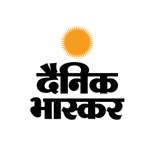
Regional Media Print Coverage of Intellecap and Transform Rural India Foundation’s launch of the Climate Action Platform on 13th Dec with support of Jharkhand State Government
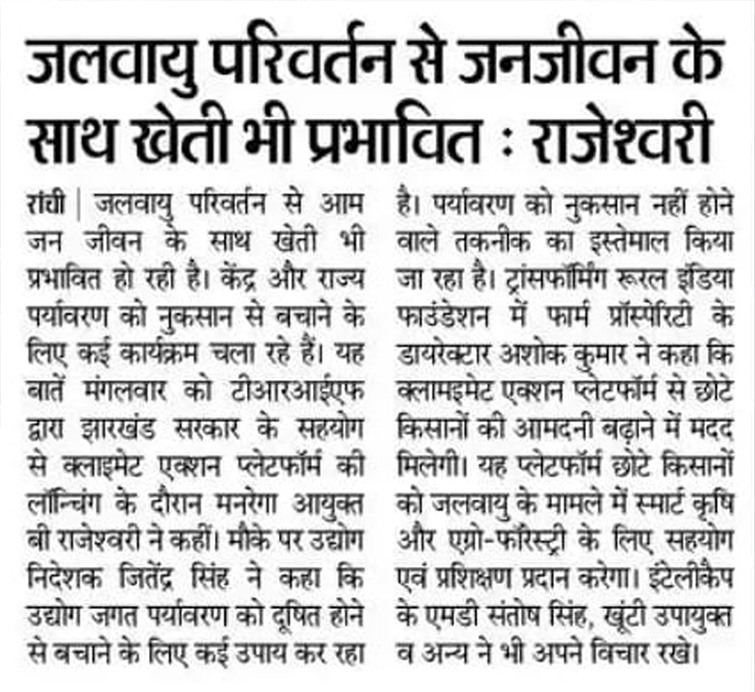

TRIF and Intellecap launch Climate Action platform with Jharkhand State Govt. – Extensive Regional Media Coverage
Mumbai 15th Dec– Transform Rural India Foundation and Intellecap launch Climate Action platform with support of Jharkhand State Government to enable smallholder farmers– Follow the Regional Coverage
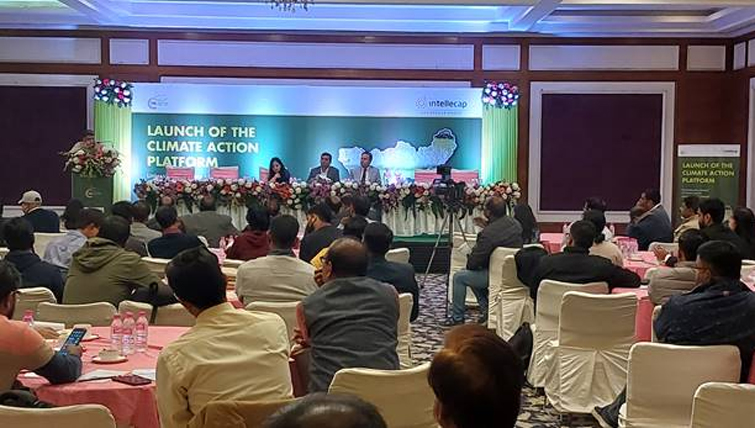
Platform will enable smallholder farmers with additional resources and knowledge to undertake climate change mitigation and adaptation activities by leveraging climate and carbon finance
Intellecap and Transform Rural India Foundation (TRIF) announced the launch of a Climate Action Platform with the support of the Jharkhand State Government on the 13th of Dec at Hotel Chanakya, BNR Ranchi.
The platform, launched by Anish Kumar, MD, TRIF and Santosh Kr. Singh, MD – Agri and Climate, Intellecap, will enable smallholder farmers from the state to leverage climate/carbon finance for agriculture and allied sectors and develop their technical skills through a capacity-building program. The platform will provide support and training to smallholder farmers for climate smart agriculture and agro-forestry.
The Climate Action platform was launched during an exclusive workshop, where keynote addresses were made by Senior State Govt. officials, Senior Leaders from Intellecap and TRIF, and attended by the farmer organizations, academic and research organizations, NGOs, Agtechs, financiers, to create awareness about climate-resilient agriculture and the role to be played by the Intellecap-TRIF platform.
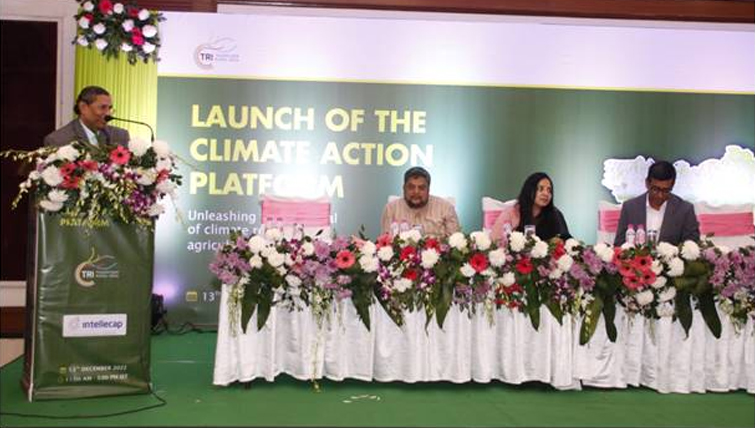
Smt. B Rajeshwari, IAS, MGNREGA Commissioner, Rural Development Dept., Dr. Shivendra Kumar, Former President, ICAR RCER, Eastern Zone, Jitendra Kumar Singh, IAS, Industry Dept., Sanjeev Kumar, IFS, Sashi Ranjan, IAS, Deputy Commissioner, Khunti Jharkhand and Koyel Mandal, Chief of Programs, Shakti Sustainable Energy Foundation spoke at the event which also had a panel discussion on the impact of climate change on the smallholder farmers of the state and key interventions to undertake climate change adaptation and mitigation in the agri and forestry sector.
The Group was well represented through Santosh Kr Singh, MD, Intellecap who launched the platform and by Sanchayan Chakraborty, Partner, Aavishkaar Capital who spoke about the importance of Climate Finance.
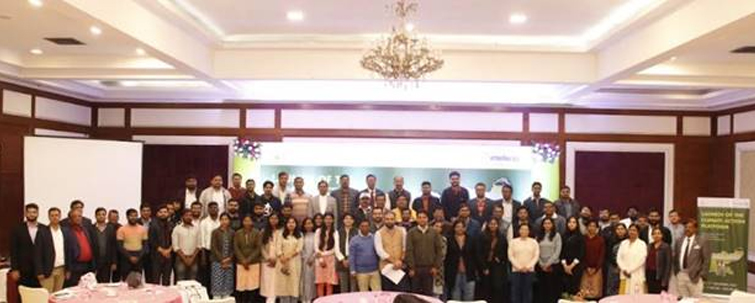
In the pic- Attendees to the workshop with TRIF, Intellecap leaders and State Govt. Dignitaries
Coverage in News 11

Regional Media Coverage (In Print)
The launch was covered by all the regional dailies namely Dainik Bhaskar, Jharkhand Darshan, Purvanchal Surya, Bihan Bharat, Ek Sandesh, Punch, Jharkhand Ujwala, Naveen Mail, Prabhat Khabar, Rashtriya Khabar, Deshpran to name a few
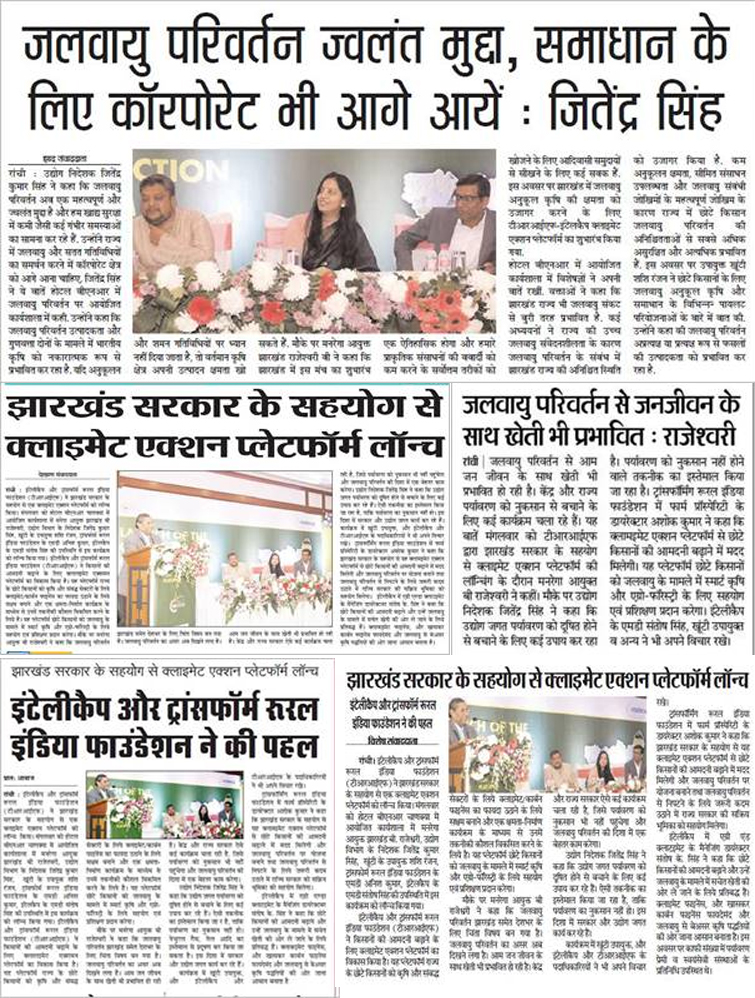

Odisha Govt Launches ‘Odisha AgTech Challenge 2022’: A Joint Endeavour of Govt. of Odisha, World Bank, FCDO and Intellecap – Coverage in Krishi Jagran
Mumbai 14th Dec– The Government of Odisha, with funding from the World Bank and the Foreign, Commonwealth & Development Office of UK, has launched the ‘Odisha AgTech Challenge 2022’ at the 3rd Make in Odisha Conclave 2022. The Challenge was enabled by Intellecap.
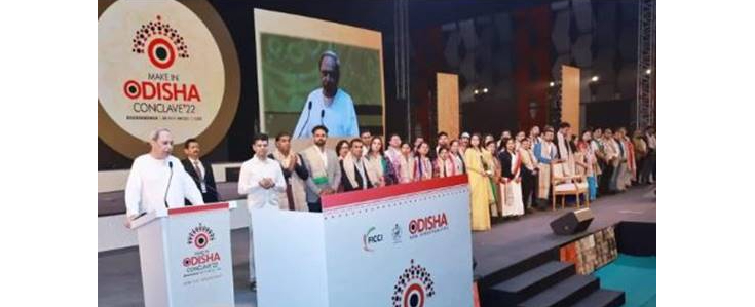
The agricultural sector in Odisha engages ~60% of the total workforce and accounts for ~18% of Gross State Domestic Product (GSDP). While there has been a positive trend in farmers’ income in the state, this is a pivotal opportunity to leverage technology to bolster this trend further.
The challenge aims to solve critical issues in key agriculture value chains and increase farmer profitability in Odisha. The challenge was launched under the guidance of Pradeep Kumar Jena, IAS, Agriculture Production Commissioner -cum- Additional Chief Secretary, Arabinda K Padhee, Principal Secretary, DA&FE, Asit Tripathy, IAS (Retd.), Principal Advisor to Chief Minister, Prem Chandra Chaudhary, IAS, Director of Agriculture & Food Production, Sanjeev Kumar Chadha, IFS, Special Secretary, Dept. of Agriculture & Farmers Empowerment, and Rohit Kumar Lenka, IFS, Director of Horticulture, Govt of Odisha. GDi Partners and Intellecap, a global impact advisory firm, is supporting the execution of the challenge.
This Challenge is presently seeking applications from AgTech Enterprises that are working in key agriculture value chains to test or scale their product through a pilot project in the state, as well as providing farmers with access to affordable, modern-age solutions to the challenges they face. Selected AgTech Enterprises will receive financial support through grants to scale-up their operations, as well as outreach, incubation and mentorship support, and on-ground network support to conduct pilots in Odisha.
The Odisha AgTech Challenge is part of the ‘Modernizing Agriculture and Allied Sector’ or MAAS-O programme, where GDi Partners along with the World Bank are leading the creation of a strategy for the State Government to align with the “One Nation, One Market” initiative of the Union Government, for enhancing state capacity, improving coordination among the various departments working for farmers’ welfare and leveraging innovative agriculture technologies to fast-track an increase in farmers’ income.
Speaking at the launch, Arabinda K Padhee, Principal Secretary, DA&FE said, “The Government of Odisha is committed to catalyzing an increase in farmer incomes across the state by partnering with the private sector in Odisha to improve the efficiency of agricultural supply chains, financing facilities and marketing. We are excited to launch the Odisha AgTech Challenge 2022 to promote innovation & technology while improving state-wide agricultural productivity and efficiency”.
The agricultural sector in Odisha engages ~60% of the total workforce and accounts for ~18% of Gross State Domestic Product (GSDP). While there has been a positive trend in farmers’ income in the state, this is a pivotal opportunity to leverage technology to bolster this trend further. The Challenge, led by the Department of Agriculture and Farmers’ Empowerment (DA&FE), has partnered with the Department of Fisheries and Animal Resources Development (F&ARD), the Odisha Millets Mission and Startup Odisha to further this initiative.
Dr. Oliver Braedt, Practice Manager, Agriculture and Food Global Practice (South Asia) for the World Bank, said, “The Odisha AgTech Challenge addresses a critical challenge of harnessing the innovation and dynamism happening in the digital agriculture space to improve outcomes for farmers in Odisha through supporting selected Enterprises to conduct pilot projects. This Challenge has the potential to demonstrate innovative solutions that can be scaled up across the country.”
The Odisha AgTech Challenge 2022 is seeking applications across 6 themes: Market Linkage Solutions, Satellite-based Services, Crop Advisory, Access to Agriculture Inputs and Fodder, Access to Finance, and Post-Harvest Processing and Storage. AgTech Enterprises with a specific focus on agriculture, especially millets, fisheries, animal husbandry, and horticulture, are welcome to apply.
According to Pravanjan Mohapatra, AVP at Intellecap, “The Odisha AgTech Challenge is a novel way for AgTech Enterprises to test and validate their minimum viable product in a supportive ecosystem, the underlying impact and knowledge of which will be very significant for the agriculture sector in Odisha as well as for the whole country. We are excited to work with the Govt. of Odisha, the World Bank and other key partners in finding Enterprises who will be joining us in this journey to help transform Odisha through their innovative solutions, which in turn will enable farmers, address critical challenges across the value chain, and improve agricultural productivity”.

Shakti Foundation and Intellecap launch Acclimate Fund – Coverage in Mint
Mumbai 28th Nov– Shakti Sustainable Energy Foundation (Shakti) on Friday announced the launch of the Acclimate Challenge Fund, in collaboration with Intellecap Advisory Solutions. The objective of the fund is to strengthen and help accelerate the work of civil society organizations (CSOs) committed to climate action in India.
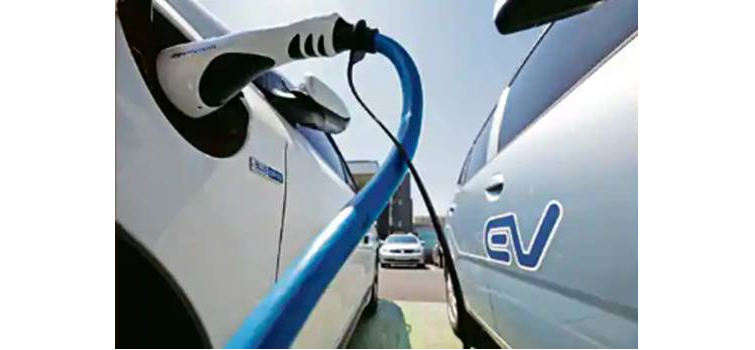
The objective of the fund is to strengthen and help accelerate the work of civil society organizations committed to climate action in India.
The fund aims to provide capacity building opportunities in areas that include electric mobility, green hydrogen, sustainable transport, industries, cooling, net-zero buildings (Bloomberg)
CSOs stand at the core of the fight against climate change by tackling the climate crisis in India on various fronts. Recognising CSOs as a dynamic source of strategic and innovative climate action, Shakti and the ACCLIMATE Challenge Fund aims to provide capacity building opportunities in areas that include electric mobility, green hydrogen, sustainable transport, industries, cooling, net-zero buildings, agriculture, coastal ecosystems, and climate finance, using a cross-sectoral approach. It will seek to facilitate general operating support and bespoke capacity building and mentorship for shortlisted organizations for a duration of 2 years.
The Challenge Fund aims to stimulate tailored responses to local context-specific problems by tapping into local knowledge and creative capacity which is often the forte of CSOs who are deeply immersed in the context. The fund will engage and channel additional resources into organizations to initiate, implement and evaluate activities in a specialized field of climate mitigation. In many cases, such support has a significant impact on the effectiveness of these organizations in fulfilling their missions.
ACCLIMATE seeks to engage with:
1) CSOs with an exclusive focus on climate action who want to expand into new sectors.
2) CSOs working in areas such as economic research, industrial competitiveness, rural development, urban planning, poverty alleviation, education, etc. who are looking to expand their work by building capacity on climate action.
The first phase of the Challenge Fund aims to build technical capacities of CSOs to work on climate change mitigation across two thematic areas of intervention -Policy Research and Analysis and Strategic Communications.
Speaking about the launch, Dr. Anshu Bharadwaj, CEO, Shakti Foundation, said, “Fighting climate change needs the contribution of all critical stakeholders, especially civil society organizations who are at the forefront of implementing solutions at the last mile. Through the ACCLIMATE fund, we would like to leverage and maximize the impact of the work done by these organizations by building their technical capabilities in the climate change space. We anticipate that these grants will help them to strengthen their operations and enhance their impact. Shakti would like to create a network of capable partners to build high quality evidence at the grassroots level, and make climate change an important priority at the local and state government levels. This will help us to design and build contextualized implementation strategies based on local knowledge and expertise.”
Vikas Bali, CEO, Intellecap said about the Fund, “Intellecap’s uniqueness lies in its ability to traverse both the realms of civil society and business with equal ease. Through the ACCLIMATE Fund, Shakti and Intellecap will seek to build meaningful partnerships with CSOs, who are many-a-times the implementers of solutions. We are glad to partner with Shakti, one of our closest compatriots towards our journey towards a sustainable future for the global south.”
As part of its mission to to facilitate India’s transition to a cleaner energy Shakti, through the Challenge Fund, aims to stimulate tailored responses to local context-specific problems by tapping into local knowledge and creative capacity by engaging and channelling additional resources to initiate, implement and evaluate activities in a specialized field of the climate mitigation.
The Challenge Fund invites CSOs to develop innovative and pathbreaking solutions centred around the two thematic areas of policy and research, and strategic communication mentioned above and submit their applications here.
The applications for the fund are open for organizations across India. The last date to submit applications is 15th December, 2022.
“Textiles industry gets ready to go circular”- Circular Apparel Innovation Factory’s exclusive story in Business India’s Special Climate Edition, Nov 2022 Issue (Print & Online)
Mumbai 16th Nov– Venkat Kotamaraju, Director, Circular Apparel Innovation Factory (CAIF), Intellecap and CAIF’s overall effort to take the Industry to go circular was featured in Business India’s Special Climate , Edition, Nov 2022 Issue.

Titled. “Textile Industry gets ready to go circular” the in depth 6 page story by Arvind Gupta. Asst Editor, Business India featured conversations with Venkat and featured the work of CAIF extensively, and other ecosystem players, and highlighted the move to support integration of the circular economy to be institutionalized and led by the Ministry of Textiles.
This is the a follow up second big story on CAIF by Business India. The first one was a year ago titled, ‘The Textile & Apparel sector looks to build capabilities to drive the transition to a circular economy’ , Nov 2021 Issue and featured the initial steps that CAIF was building to connect and co create the ecosystem.
Textile and apparel (T&A) manufacturing is considered to be one of the most polluting industries. In fact, the T&A industry is the second-most polluter globally. Over 20 per cent of industrial water pollution is due to garment manufacturing. Globally, 80 per cent of textile waste generated is not recycled and is often sent to landfills or incinerated. In fact, the industry is responsible for over 8 per cent of global pollution.
With a growing economy and changing demographics, the consumption of textiles and clothing has gone up by more than 60 per cent today as compared to that in 2000 and this has significantly aggravated the whole situation. In the past 15 years, textile production has almost doubled.
Amidst all this, the industry finds itself in a quandary as it is struggling to balance its mainstream targets of productivity & production and its sustainability goals. The current linear system of production, distribution and usage of T&A is not sustainable as there is less regard for environment impact.
Experts are of the view that the current ‘take-make-dispose’ approach does not only adversely impact environment and society, but also the future business of the T&A industry.
“A circular economy can be a game changer for Indian suppliers and manufacturers of textiles and apparel. Indian suppliers and manufacturers stand to make considerable gains if they proactively adopt good practices and innovate through circular business models and practices and get ready to be part of the transformation that is happening globally. However, global discussions on circular economy have to be clearly contextualised for India. India is both a major producer and consumer of textiles and apparels and any circular economy intervention has to be aligned to the requirements of the value chain actors in India,” says a report by the Centre for Responsible Business (CRB), a think tank based out of New Delhi, which has created the framework to capture circular economy priorities or action points in alignment with the principles of a circular economy. This paper has been developed through extensive engagement with the stakeholders of the Indian T&A industry and identifies CE priorities in the Indian context.
The Indian apparel and textile sector contributes significantly to the Indian economy in terms of manufacturing, employment, exports and GDP. The A&T sector is a crucial component of India’s economic backbone. It contributes about 2 per cent to India’s GDP, and employs about 10.5 crore workers in the A&T and allied sectors.
India is the sixth-largest apparel and textile exporter of the world. India’s total exports of textile and clothing are about 12 per cent of its exports. Apart from a growing presence in exports, India has been witnessing quick growth in the domestic market due to rapid urbanisation, increasing disposable income, increasing customer base and retail penetration.
Sustainability thrust
“With the world’s biggest fashion brands increasingly committing to net zero targets we are witnessing an upwards momentum for sustainability in the international fashion arena. This era of environmental and social awareness, as well as governance in the textile industry has to be the major focus for India. Concerted policy action such as the European Union’s Circular Economy Action Plan, which paves the way for the transition to a circular economy, the recently introduced New York Fashion Bill for supply chain mapping, and other such positive international developments will significantly affect the Indian textile sector given its crucial role in the global textile and apparel value chains,” says Atul Bagai, Head, United Nations Environment Programme, Country Office, India.

In the Pic: Over 20% of industrial water pollution is due to garment manufacturing
UNEP’s work focuses on the value chain approach for interventions in the textile sector. It believes that coordinated actions in all regions by all stakeholders (government, industry, and consumers) and changes at each stage in the value chain involving players of all sizes and market segments are required to transition to a more sustainable and circular fashion.
Additionally, stronger governance and policies are critical. UNEP is developing a roadmap for a collaborative pathway towards greater sustainability and circularity in the textile value chain.
“Circular economy offers a promising pathway for the Indian T&A industry, which endeavours to become a global leader in sustainable manufacturing and exports of high quality garments. With the right kind of investment and upskilling of young workers, circular economy can unlock millions of green jobs. The circular economy also enables manufacturers to reduce their environmental footprint by keeping value in the system longer and thus reduce waste. This is very crucial for the sector as resource scarcity, especially the lack of clean water can be detrimental to both industry and the society at large,” states Upendra Prasad Singh, Secretary, Ministry of Textiles, Government of India.
“The Union ministry of textiles is committed to promoting sustainable development of the economy where the T&P industry can play a key role. The ministry has launched a series of schemes over the years to upskill garment workers and make them future-ready as smart manufacturing and automation continue to shape the manufacturing landscape,” adds Singh.
“Circularity is becoming very important and all leading global retailers have set targets to reduce their carbon footprint – garments and textiles exporters have realised that it is no longer just talk; it’s reality and needs immediate action. However the speed of action will depend on the buyer’s push and requirements,” says Sanjay Jain, past chairman, Confederation of Indian Textile Industry (CITI) and MD, TT Ltd.
“The concept of ‘reuse, recycle and reduce’ can take us towards the sustainable future in the years to come. We have become more materialistic without many constraints and this is damaging our very own environment. Regarding recycling of products, we are moving in the right direction but this alone is not sufficient. The other two are also very important elements which need to be imbibed in our daily lifestyle. Innovative technologies and enhanced cooperation between the industry, academia and government will be the key enablers towards sustainability in the sector,” says Prof RS Rengasamy, Department of Textiles and Fibre Engineering, Indian Institute of Technology, Delhi.
According to a Bain & Company research report, circularity represents a decoupling of economic growth from resource consumption. For companies, it means conserving materials, extending a product’s lifetime through repair and reuse, and ultimately recycling. It also includes improving utilisation through new business models, such as those that offer products as a service, and sharing economy platforms.
The Bain & Company research conducted in partnership with the World Economic Forum shows that business leaders increasingly feel a sense of urgency about embracing circularity. Circular disruption is underway in many industries, often led by new entrants with innovative business models. In a recent survey of senior executives, it found that leadership teams grow more aware that they are vulnerable to circular disruption the more time they spend preparing for it. In its study, it states that supply chain executives are planning to double the share of revenue from circular products and services by 2030.
“A company’s supply chain must be resilient as well as sustainable. In view of increased concerns about climate change and the environment, a circular and sustainable supply chain will need to not only apply rules that benefit society and the environment, but also ensure that resources are available for the future. As a result, it is critical for businesses to assess and reconsider their supply chain options, emphasising sustainability, flexibility, agility and efficiency,” says Dipali Goenka, MD & CEO, Welspun India.
Meanwhile, the Indian textile sector is also gearing up to adopt circularity in its value chain. One such effort is the formation of an industry-led platform – Circular Apparel Innovation Factory (CAIF). Started in 2018 and formally launched in November 2019 at Sankalp Forum’s 11th Global Forum in Mumbai, CAIF is a global initiative of Intellecap, the impact advisory arm of the leading impact investing organisation, Mumbai-headquartered Aavishkaar Group, which works to build businesses that can benefit the underserved segments across Asia and Africa. Intellecap builds enabling ecosystems and channels capital to create and nurture a sustainable and equitable society.
Building an ecosystem
CAIF is supported by the DOEN Foundation, a Dutch foundation supporting initiatives in the field of culture and cohesion and in the field of green and inclusive economy, as also Aditya Birla Fashion & Retail Ltd (ABFRL) as its founding anchor partners. To accelerate the shift of the industry from its current ‘take-make-dispose’ approach to one that is more circular across the lifecycle, CAIF works with a diverse group of stakeholders from across the value chain.
“As an industry-led platform, CAIF’s mission is to build the ecosystem and strengthen capabilities to drive the transition to a circular economy in the apparel and textile industry. The platform is building the textile industry’s innovation infrastructure by bringing together key stakeholders to collaborate and work together on achieving the five key circular goals: increasing the use of sustainable inputs and material; maximising the utilisation of clothing & textiles; increasing the recycling of clothing; boosting production through renewable inputs and minimising negative social impacts and increasing social responsibility,” says Venkat Kotamaraju, Director, CAIF.
CAIF’s vision, roadmap and day-to-day programmes are shaped and informed by a neutral industry-led and industry-facing governing body which comprises leaders from organisations including ABFRL, The DOEN Foundation, Arvind Ltd, H&M, Marks and Spencer, UN Environment Program, UNIDO and Vikas Bali (CEO Intellecap).
CAIF has been partnering and collaborating with over 15 brands and manufacturers (local, regional and global) directly through programmes in India and Bangladesh. Through different initiatives, CAIF’s network includes over 400 innovators and solution providers (local, regional and global), which it partners with and enables through capability building and facilitating partnerships with brands and manufacturers across programmes. CAIF’s construct for engaging innovators and solutions providers is through the time-tested 4S ecosystem approach of Search, Seed, Support and Scale.
In the next 24-36 months, CAIF will be looking to partner with 30-40 like-minded and value-aligned organisations, through which it will further build the ecosystem and capabilities across value chain stakeholders. These partnerships will catalyse change on the ground – strengthening and expanding its work in India, Bangladesh, East and West Africa, as well as SE Asia.
These partnerships will include entrepreneurs, civil society organisations, think tanks, industry bodies and policy actors to create an enabling environment to realise tangible impact goals for MSMEs, entrepreneurs, brands and retailers.

In the Pic: With the right kind of investment & upskilling of young workers, circular economy can unlock millions of green jobs
The T&A platform is targeting these regions because they are critical in the fashion industry’s global value chain. They are critical since the global South accounts for a significant amount of manufacturing for the global value chain of the global industry. For example, India is one of the biggest importers of textile waste from the US and Europe.
The country recycles it and sends it back. Besides, more than 50 per cent consumption of fashion and apparel is in the global South. Global South include economies outside the developed economies like the US and Europe.
“With the global South economies being significant contributors to sourcing, manufacturing, exports, recycling and consumption in the complex global value chain, it was crucial for the global south to have a voice and a seat at the table. While there was growing momentum globally (especially in Europe) from individual organisations, we saw an opportunity in taking an ecosystem approach that will not just surface the dots (gaps and stalemates) but also help connect the dots (mobilising capital, knowledge and networks to build the ecosystem) in interesting ways for impact to happen at scale. More importantly, while the dominant narrative globally around the circular economy emphasises economic and ecological value creation, CAIF aims to alter this narrative that also includes how we ensure no individual or group is left behind on this path towards progress,” explains Kotamaraju.
Ambitious targets
CAIF is looking to make the work of the apparel, textile and fashion industry more sustainable (resource-efficient, resilient and responsible) through reducing carbon emissions (both avoidance and removal), while creating green and circular jobs for those employed across the value chain. Some of the partner brands and manufacturers have very clear and ambitious targets like for example moving to recycled water usage (away from fresh water) by 70-100 per cent between 2025 and 2030, eliminating energy usage and consumption by 30-50 per cent by 2030, replacing virgin material usage with recycled material use by 50-70 per cent by 2030, etc.
While a platform like CAIF is helping the industry be compliant to meet sustainability goals, individual textile organisations are also formulating their policies.
Arvind Ltd has continued to push boundaries with its allies across all its six key inputs – cotton, people, money, energy, water and chemicals. The denim major along with Better Cotton Initiative (BCI) has led the implementation of the Better Cotton Standard, laying the foundation for more sustainable cotton production.
For the textile industry, wastewater is a major challenge. With Levi’s and the Zero Discharge of Hazardous Chemicals (ZDHC) programme, Arvind is eliminating hazardous chemicals from the value chain. This has helped it in eliminating harmful chemicals from its processes, reduce chemical consumption, substitute hazardous with greener chemicals, and recover salts from wastewater to keep the environment clean.
Energy is as significant a material issue as water and Arvind is optimising energy productivity and adding renewables to the energy mix to conserve this resource. In the last few years, it has been able to cut down its total direct and indirect emissions by around 15 per cent. Its Ethiopia operations are fully powered by renewable energy. Its ally, Cleantech Solar, has helped it install a 16.2-MW rooftop solar at its Santej facility in Gujarat, which is India’s largest rooftop solar installation at a single location.
The company is also working with farmers to use residues of cotton crop in boilers instead of coal to generate steam from biomass. This programme will be scaled up further in the coming years.

In the pic: A&T sector is a crucial component of India’s economic backbone
“Climate change has fast emerged as the most fundamental challenge that the textile industry is facing today, which involves environmental protection, economic and social development. Contributing to sustainable development is the only way we can counter rising temperatures, limited freshwater, and changing weather patterns. These changes have a direct impact on the production of natural fibres such as cotton, which is the mainstay of the textile industry. At Arvind, we have a two-pronged approach to deal with it. We are fundamentally right ourselves, as an organisation, in the issues which are material to our stakeholders and collaborate with our allies to amplify our sustainability efforts,” says Sanjay S. Lalbhai, Chairman & Managing Director, Arvind Ltd.
“Throughout the pandemic, the PDS Group has shown itself to be resilient in the face of global health and economic challenges, which is a credit to our staff, our customers, and our suppliers who have continued to support us, and my leadership team which has been steadfast and dedicated. In the not-too-distant future, the world may face disruption and devastation if we do not address climate change, biodiversity and nature loss, and inequality. At PDS Group, we are committed to ensuring that together with our partners we build a better, more sustainable supply chain,” says Sanjay Jain, CEO of apparel major, the PDS Group.
While textile players are carrying out initiatives and interventions, the CRB team, meanwhile, has identified CE interventions based on secondary research and extensive stakeholder consultations across various value chain actors especially with brands (domestic and international), suppliers and manufacturers, dyeing and chemical companies, academia, innovators, and state government officials.
These ideas, aligned to the CE priorities defined in the framework, have been broadly categorised as actions proposed for practitioners and as possible policy interventions.
Some of the main recommendations: guidelines defined indicating the types of material to be used (virgin + recycled); chemicals to be avoided/used; designs for durability; designs for end-of-life processes/purposes; cost of collection for end of life factored in; clear labelling (transparency and traceability); patterns/design innovation (role of designers and brands).
“Towards this end, there is a need to issue an advisory on textile production parameters and processes and constitute a task force (suggested to be anchored with the ministry of textiles) that can facilitate the setting of industry guidelines for circular design and manufacturing amongst industry players. For eg Ellen McArthur’s guidelines on jeans manufacturing; waste water effluent standards for the textile and dyeing industries should be developed by the Central Pollution Control Board along with the State Pollution Control Boards under the supervision of the Ministry of Environment, Forest and Climate Change. Implementation guidelines should be prepared by CPCB with significant empowerment to ULBs to sensitise with local needs,” recommends the CRB research.
CRB believes that there is a need to work with alternate materials that are less water- and energy-intensive, can be easily recycled, and are more durable. Some examples are hemp, banana fibre, and other sources of cellulose. Emphasis has to be given to manmade fibres and extensive R&D is needed both for alternate materials and cost-effective recycling technologies. Further, innovations in these areas should be supported. Transparency and traceability will be required to authenticate material sources and fibre content to support recycling.
Reducing waste
While managing waste from the apparel & textile sector, CRB says that pre-consumption waste can either be reduced through technology adoption (for larger units) or through linking production units to upcyclers/ recyclers to prevent waste from going to landfills. Consumers need to be educated and incentivised to recycle used garments. Reverse logistics need to be considerably strengthened to support a recycling/upcycling/repair eco-system.
The need for energy-efficient machinery and use of cleaner energy is well understood amongst industry actors. However, the need for a stable policy has been identified as a major requirement. This policy ought to be long-term and stable as renewable energy requires large investments from companies.
Innovation at the MSMEs should be promoted (including handicrafts), focussing on in-situ technical/technological innovations. Official case studies should be documented and scaled/replicated elsewhere. The Technology Upgradation Funds Scheme (TUFS) should be amended to include more energy-efficient technologies/equipment.
As per CRB, the industry can undertake detailed water audits to measure its water footprint along its operations and identify measures to reduce water consumption. Technologies for wastewater treatment are very costly at the moment and adoption at scale is hindered. Incentives can be provided for the use of recycled water.
Regulations can be passed to mandate the partial use of recycled water. Modernisation of dyeing units should be incentivised as this directly impacts the consumption of water. Common infrastructure will need to be considered for smaller units and all polluting processes can be clustered in a common facility.
The think tank believes that a systematic, human-centred transition to a circular economy is needed for the textile and apparel industry for better environmental and social performance, as well as to improve competitiveness and improve market access. Opportunities are also emerging for attracting international and domestic sources of sustainable (ESG) finance, especially with the Government of India developing a roadmap on Sustainable Finance in India. Continued and concerted support involving various segments of the government at all levels is needed to create the enabling environment for circularity.
For seamless adoption of CE intervention, skill and capacity building of workers and entrepreneurs is required and is critical, especially from the point of a ‘just transition’. This will ensure that a circular transition not only creates new job opportunities but also that existing jobs are protected in a transitioning sector. Further, certain categories of consumers can start to play a key role in influencing both national and international brands.
A move to support integration of the circular economy must be institutionalised and led by the ministry of textiles. The ministry should develop a roadmap for the sector, with inputs and consultation with suppliers, exporters, brands, experts, CSOs, etc. Besides, EPR and reverse logistics need to be deployed especially by brands/buyers to reduce textile waste, says the CRB report.

In the Pic: Globally, 80% of textile waste generated is not recycled and sent to landfills or incinerated
Making a green statement
Tirupur has set a precedent by emerging as a truly sustainable apparel-making hub
Knitwear cluster Tirupur in Southern India has today emerged as a completely transformed apparel manufacturing hub. Just a few years ago it hosted one of the most polluting textile units in the country. This evoked massive protests by local farmers and other communities after which the Madras High Court ordered the closure of 750-odd dyeing and bleaching units in this cluster for not complying with the State Pollution Control Board’s zero-liquid discharge ZLD norms.
Today, Tirupur is a completely ‘Zero Liquid Discharge’ garment cluster and the water used by its dying and processing units is treated at common affluent treatment plants and reused. By doing so, it not only consumes significantly less water but also does not discharge any polluted water.
Having emerged as a sustainable sourcing destination for knitwear, the R60,000-crore business (which exports half of its production to the global market) currently has 300 dyeing units attached with 18 Common Effluent Treatment Plants (CETPs) and 60 dyeing units with their own Individual Effluent Treatment Plants (IETPs).
The CETPs and IETPs in Tirupur have successfully implemented Zero Liquid Discharge (ZLD) – a first of its kind, globally. Every day 18 CETPs recycle 100 MLD of water and 60 IETPs recycle 20 MLD of water. The effluent is treated to recover 94 per cent of the water, which is resent for processing and the remaining 6 per cent is recovered as salt solution or salt to reuse for various processes.
“We as a cluster have shown a great degree of resilience and perseverance to reach where we are today. We are proud of having transformed Tirupur into a green hub where most of the resources are used in a sustainable manner. The initial years were really difficult as these dyeing units were in no position to comply with ZLD requirements. But we have managed to overcome all challenges to set up one of the most sustainable circular fashion supply chains,” says KM Subramanian, President, Tirupur Exporters Association and managing director of the Rs750 crore KM Knitwear, which exports 50 per cent of its knitwear production to the global market.
“For almost 10 years, we have been strictly pursuing our ZLD model and along the way we have also taken up multiple projects which are aimed at significantly reducing our carbon footprint. As a green cluster, we have gone ahead,” says A Sakthivel, President, Federation of Indian Export Organizations; chairman, Apparel Export Promotion Council and founding president of TEA.

Kumar Duraiswamy, joint secretary, TEA says that the toxic effluents generated during the processing of fabrics were depleting the ground water level before implementation of ZLD, but that has been now completely eliminated and the treated water is reused for the processing of fabrics.
“Our efforts have paid off. Apart from the successful implementation of ZLD, we are doing multiple things to positively impact our surrounding and environment. In fact, we have set a precedent that others can also emulate and help build a more sustainable ecosystem for the industry,” states N Thirukkumaran, General Secretary, TEA.
“Tirupur as a knitwear hub has come a long way. Each and every stakeholder has played a role in making this cluster a truly sustainable garment manufacturing one. We will continue to carry on with our endeavour to take this success story to the next. “ Gopalakrishnan, Chairman, Royal Classic Mills
“Tirupur as a knitwear hub has come a long way. Each and every stakeholder has played a role in making this cluster a truly sustainable garment manufacturing one. We will continue to carry on with our endeavour to take this success story to the next level,” says R Gopalakrishnan, Chairman of Tirupur-based Royal Classic Mills. Led by flagship knitwear brands like Classic Polo, the Rs750-crore company boasts the largest IETP in Tirupur.
Besides ZLD implementation, Tirupur units have installed both solar power plants and wind energy generators, producing 1,600 KVA per day, whereas the power consumption of the industry in the Tirupur cluster is only about 250 KVA. Moreover, the overall power consumption of the entire district of Tirupur is 650 KVA. Hence the excess green power produced is distributed through the Tamil Nadu power grid.
In another significant initiative called ‘Vanathukul Tirupur’, a mass tree plantation drive has been carried out by an NGO called VETRY. Supported by Tirupur garment units, VETRY, during the last 8 years, has planted 15 lakh saplings.
Rainwater harvesting is one of the major activities being followed widely in the cluster. In the last few years, the amount of rainwater harvested has made many factories self-sufficient in terms of water usage.
“Going beyond carbon”- Santosh Singh and Kavya Hari, Intellecap featured in Business India’s Special Climate Edition, Nov 2022 Issue (Print)
Mumbai 16th Nov– Santosh Singh, Managing Director and Kavya Hari, Manager, Intellecap was featured in Business India’s Special Climate , Edition, Nov 2022 Issue through an exclusive guest column titled, “Going beyond Carbon” where they talk about new frontiers of sustainability commitments that are yet to be crossed.
The landscape of climate commitments by corporates/ businesses is evolving rapidly, as society and governments accelerate their response to the climate crisis. Globally, 7,000+ corporates/ businesses have pledged to accelerate net-zero as a part of the UN’s ‘race to zero’ campaign and 1,400+ have set science-based net-zero targets verified by the ‘science-based target initiative’ (SBTi). While carbon abatement has been established as the key constituent for mitigating ill-effects of climate change, multiple other associated issues need to be addressed. These include water scarcity, plastic pollution, soil degradation and bio-diversity loss. According to the UN, about a million species are threatened today with extinction but the fact is that the current response to the impending bio[1]diversity loss is insufficient. UNICEF assesses that about two-thirds of the global population experiences severe water scarcity for at least 30 days in a year, while over two billion people live in regions with inadequate water supply. The impact of water scarcity could lead to the displacement of around 700 million people by 2030. Another UN agency, UNEP suggests that up to 200 million tonnes of plastic can be found in our oceans and a projected 23-37 million tonnes could be added every year by 2040.
Emergence of ESG compliance and regulations: Today, business stakeholders, investors and regulators are demanding that companies provide an assessment or report on how their businesses are operating in the context of ESG dimensions. This facilitates them to make informed decisions by identifying corporates/businesses prone to risks and/or underperforming on various environmental metrics compared to those adopting sustainable practices. The investors also expect climate commitments to be science-based and linked to the core business strategy of the corporates/ businesses. As of date, more than 270 investors, with $61.3 trillion in assets under management, have signed a pledge with the ‘net-zero investors’ initiative’; to support the goal of net-zero emissions by 2050.
There are various principles, frameworks and standards that are guiding the ESG reporting. They include ‘global reporting initiative’ (GRI), ‘carbon disclosure project’ (CDP), ‘task force on climate[1]related financial disclosures’ (TCFD), SASB standards, ‘international integrated reporting framework’ and ‘international sustainability standard board’ (ISSB). Emerging markets have also ramped up their efforts in improving ESG standards aligned to global best practices. India has introduced its own business responsibility & sustainability reporting’ (BRSR) framework that is mandatory for top 1,000 companies. This framework intends to set standardised and quantitative disclosures on ESG parameters for corporates/ businesses across sectors. BRSR covers nine core principles — integrity, safety, employee well-being, stakeholder management, human rights, environmental protection, public policy, inclusive growth and consumer engagement to address, which are the key ESG parameters. It is aligned to reporting requirements of TCFD, GRI, CDP and SASB and is inter-operable with most international frameworks. This enables corporates/ businesses already disclosing sustainability reports on these international reporting standards to cross-reference the disclosures required under BRSR.
However, an analysis of the various existing ESG reporting standards and allied corporate climate commitments showcases significant focus on climate mitigation outcomes. The scope here to account for other challenges impeding sustainability is limited indeed.
Focus on carbon plus sustainable benefits: Recent developments such as framework for ‘taskforce on nature-related financial disclosures’ (TNFD), SBTi’s guidelines for forest, land and agriculture (FLAG), ‘guidelines for planning and monitoring corporate bio-diversity performance’ by IUCN, ‘the global commitment and circular economy for plastic use’, led by Ellen MacArthur Foundation – these are all paving the way for carbon plus initiatives. In India, the scope of environment within the BRSR framework also attributes value to environmental/ sustainable outcomes beyond energy and GHG/ scope emissions reporting including aspects like solid waste management, water consumption and withdrawal, sustainable sourcing, 3R (reduce, reuse and recycle), extended producer responsibility (EPR), and life cycle assessments. Further, the BRSR framework is aligned with sustainable development goals (SDGs), thereby promoting corporates/ businesses to demonstrate their performance on achievement of SDGs beyond their climate commitments.
Leveraging the learnings from the growth of carbon market and pricing mechanisms: As corporates/ businesses begin to account for larger sustainable development aligned outcomes, we could witness a rapid shift in the market with monetisation of environmental assets (like water, bio-diversity, plastic, etc) aligned to existing carbon pricing mechanisms. Carbon markets have been helping corporates/ businesses to meet their carbon goals. The rise in net-zero targets and car[1]bon neutrality goals by corporates/ businesses has driven demand for carbon credits to an unprecedented height; with the voluntary carbon market hitting a record value of $1 billion worth of carbon credits in 2021. More than 60 per cent of the value of transactions are attributed to sectors with significant co-benefits contributing to SDGs (like clean cooking, agriculture, forestry, land use, household devices etc).
The rising focus on sustainable/ environmental outcomes beyond emission reductions has already begun development of new methodologies or labels/ certifications by independent car[1]bon crediting standards and/or new market-based mechanisms. A few examples include ‘plastic waste reduction standard’ by Verra, ‘gender standard’ by WOCAN, ‘circular credits mechanism’ by BVRIO, ‘bio-diversity credits’, etc. This new era of credits for allied segments such as bio-diversity credits, water credits, plastic credits is expected to grow rapidly in the near-term. The trajectory of these credits may be more rapid than that of carbon credits, considering the various lessons that may be applied to the former from the latter. Meanwhile, as the standards and guidelines continue to evolve and be established for the carbon market, the same may be replicated for credits from other segments, thereby shortening the route-to-market. Therefore, businesses and investors must take note of these credits as they will be jostling for capital consumption alongside carbon credits sooner than expected.
Intellecap Santosh Kumar Singh, Managing Director and Venkata Kotamaraju, Director CAIF featured on Business India’s special climate November 2022 edition
View full article
Why Venture Capitalists are doubling down on the Impactech sectors: Bikram Mahajan, Intellecap featured on Inc42
Mumbai, Nov 15th – At the 14th Edition of the Sankalp Global Summit 2022 , one of the main plenary sessions was around the topic, ImpacTech Investing: Dichotomy or Paradigm shift?, led by Bikram Mahajan, Partner, Intellecap Investment Banking Group.

Inc42 in conversation with Bikram featured the story, “Why Venture Capitalists are doubling down on the Impactech sectors” which takes that conversation ahead and highlights how when it comes to investment themes, impact and technology have always been discrete buckets for investors. Bikram also opines on how the belief that VC investing is primarily driven by financial objectives whereas impact investing is only about seeking people and planet outcomes has led to such misconception, and the truth about how impact and technology have never been two unrelated paradigms. Both styles of investing are deeply intertwined and form a continuum rather than a dichotomy.
The Rise And Rise Of Impact & Tech Sectors
A decade ago, it was easy to dismiss the impact sector as a collection of not-for-profit organisations supported by foundations and philanthropies. We’ve come a long way since then, and the for-profit impact sector is now formally recognised around the world, and impact investing is a well-defined asset class.
The global impact AUM crossed $1 Tn across asset classes in 2022. This impact AUM is managed by 3,349 organisations, where fund managers account for the majority of them. Concurrently, the startup sector observed $134 Bn invested in 5,200 startups since 2014 in India and a non-trivial $2.5 Tn in over 100,000 startups worldwide.
A new class of impact startups challenging the traditional impact business models also emerged during the last few years, piggybacking on disruptive innovation, an often quoted and generally accepted investment driver in the mainstream startup sector.
Equipped with state-of-the-art technology, impact startups exhibited the promise of accelerated growth translating into superior impact and investment multiples than their traditional impact counterparts.
A few impact investors also broadened their investment themes to join the bandwagon of investing in technology startups, even considering impact in retrospect on occasion, and a few startups that were ignored by mainstream VC funds went to the extreme of impact washing to seek impact pools of capital.
The Impact Vs. Tech Dichotomy
With 107 unicorns and one of the world’s highest unicorn minting velocities, India has only 11 impact unicorns, with no unicorns in sectors such as agritech or cleantech.
One could argue that asset managers have made unprecedented commitments to impact AUM allocation, fueling its 11% growth since 2016. However, the private markets AUM grew from $5.2 Tn in 2016 to $9.8 Tn in 2021 during the same period at a CAGR of 16%.
The gap widens when we consider that the $4.2 Tn funding required to achieve 17 Sustainable Development Goals by 2030 is just 1.1% of assets held by financial institutions.
The predicament intensifies when we combine this statistic with a survey by JP Morgan and GIIN, which found that over 55% of impact funds deliver at least market rate returns, as well as a study by MSCI, Inc. validating the stylised fact that companies with higher ESG ratings have higher profitability, lower systematic risk and lower tail risk.
Impactech Investing: A New Paradigm
From the perspective of an investor, one way to resolve this seemingly obvious conundrum is to recognise “impact” as an investment approach conspicuously integrated into a fund manager’s investment thesis rather than an asset class. Impact investing, according to the Global Impact Investing Network (GIIN), necessitates intentionality and impact measurement.
Using this globally accepted definition, Intellecap’s digital investment banking team estimated that 40% of the world’s 1,200 unicorns can be classified as Impactech startups.
The truth is impact and technology have never been two unrelated paradigms. Both styles of investing are deeply intertwined and form a continuum rather than a dichotomy. The global ESG transition being extensively embraced by tech giants, unicorns and investors across asset classes demonstrates this phenomenon.
For a startup, impactech is often misconstrued as reluctantly espousing backward fitting impact metrics as an after-thought for enhancing investment worthiness or employing emerging technologies one-dimensionally to deliver impact. Scaling up is an inherent objective of every venture, whether digital or impact, intending to solve a grand challenge.
Impactech is about designing business models from the ground up which leverage both technology and impact as sustainable competitive advantages to achieve scale. The next 3 Bn presents the largest underpenetrated market for digital businesses, whereas impact ventures are transforming their business models for scalability through digital inclusion.
Hence, impactech comprises not only a healthcare company employing technology as an enabler for scale and efficiency but also a deeptech startup exploiting big data and AI/ML to digitise and interpret diagnostic reports.
Analogously, not all edtech startups can be classified as impact and not all enterprisetech startups are non-impact. Perhaps the correct approach is to evaluate each startup with intentionality and a measurement lens, rather than defining impactech as an all-encompassing sector.
The impactech dimension has always been ingrained in the investment thesis across strategies, sectors, and stages. Reclassifying impactech as a distinct and broad-based investment theme would simplify investments at the intersection of impact and technology to empower digital businesses that solve global challenges.

Good Food Innovation Fund’s first cohort gets USD $1 Million to make better food accessible to Africans- AgFunder Network in conversation with William Mulehi from Intellecap Africa
Nairobi, 3rd Nov– The Good Food Innovation Fund (GFIF) has selected seven enterprises that are revolutionizing the availability and affordability of ‘good food’ in low-income communities in Kenya and Rwanda to receive funding and technical assistance to expand their operations. The seven SMEs will receive funding between USD 100,000 to 200,000 each, for a total of over USD 1 million.

Launched in 2021 with a USD 5 million grant from The Rockefeller Foundation, the Good Food Innovation Fund supports SMEs to expand access to nutritious and affordable food across sub-Saharan Africa while mitigating barriers such as high prices, consumer preferences, and unfavorable policies. The fund is managed by Intellecap Advisory Services.
Recently AgFunder Network, a reputed Global news network spoke to William Mulehi, Principal, Intellecap Africa on the Good Food Innovation Fund’s 1st Cohort of Winners.
Kenya’s Good Food Innovation Fund (GFIF) recently unveiled the seven companies participating in its first cohort.
As the name suggests, “good food” is the focus area for this first cohort. GFIF designates regenerative, nutritious, and sustainably and equitably produced food as good food. The fund’s goal is to make such foods more widely available and affordable in Sub-Saharan Africa by supporting companies that grow, distribute and provide that food.
The fund, which is managed by social-impact focused advisory firm Intellecap, was started in 2021 with a $5 million grant from the Rockefeller Foundation.
The seven SMEs selected from 144 applications include:
The cohort will receive financial backing of up to $1 million, with startups each getting a sum ranging from $100,000 to $200,000. A lower threshold of $50,000 is in consideration due to the small size of the companies and their ability to properly manage the funds.
Beyond financing, the fund will provide technical support on creating financial models and growth projections. It will also help companies stream line their operations and teams to get them investor ready.
Regional focus
Africa has the highest share of people suffering from food insecurity in the world, according to the United Nations. Roughly 21% of people on the continent suffered from hunger in 2020, or 282 million people. On the other side of the malnutrition scale, Africa is home to 24% of the world’s overweight children aged under 5, according to the World Health Organization.
Initially, GFIF’s call for applications cast a net on Kenya, Rwanda and Burundi, where Rockefeller was already running projects. This first cohort complements existing projects in these countries and targets institutional feeding programs, such as suppliers of fortified whole grain to schools and hospitals.
Apart from their focus on enabling access to good food, companies were chosen based on their potential impact and the uniqueness of their ideas.
“They’re the ones that were really speaking into what the project aims,” William Mulehi, an associate vice president of business consulting and research at Intellecap, tells AFN.
“There’s also a portfolio mix in terms of the impact these organizations are looking at, because we have some that have very high potential to scale and to reach the numbers that we are targeting.”
The project also aims to positively shift food policies in the select countries. For example, Agriface is pushing for fortification of food. While this fortification of staples like vegetable oils, wheat and maize flour is mandatory in Kenya, the case is voluntary for food producers in Rwanda, hence the push from the Rwandese SME.
“We are trying to support these companies with the hope that our intervention is going to have a ripple effect, in terms of policy and policy development,” says Mulehi.
Market nuances
Increasing access to good food also means increasing support for SMEs in fairly young markets.
Consider Burundi. While it’s a focus for GFIF, companies from there didn’t make the cohort owing to the country’s smaller market in comparison to Kenya and Rwanda.
“We didn’t really get strong applications from Burundi,” Mulehi says. “However, we are holding information sessions in Bujumbura [Burundi’s capital], just to take potential companies through the application process of what is required as we try to understand the market nuances in this particular country, which may have had an effect on the low uptake from the companies there.”
Though it’s not supporting the GFIF’s project directly, Burundi’s division of the World Food Programme also helped in drumming up support to get the companies to participate in the sessions. GFIF is now collecting data to tailor its upcoming call for the next cohort, making it suitable for Burundi’s SMEs to get accepted and access the fund’s support.
“In some of these markets, you need to ensure your efforts are complemented,” explains Mulehi. “WFP does a lot of institutional feeding to schools and such settings. So we are working together because there’s an overlap in our mandate. Also for them being on the ground, they have experience in terms of the type of organizations that are in the market and what sort of support that they require.”
Future cohorts
The GFIF will announce the call for its next cohort in November, widening the list of countries to include Ghana and Benin. This time, the innovation in focus will be on vertically integrated solutions such as logistics, post-harvest processing, distribution and retail.
“Our intervention should be able to go a long way in de-risking these companies, for them to be able to access new markets which they would otherwise not be able to venture into maybe due to the perceived risk,” Mulehi notes.
Reports & Policies
Our Impact Map

Sign up for our newsletter
© Copyright 2018 Intellecap Advisory Services Pvt. Ltd. - All Rights Reserved






